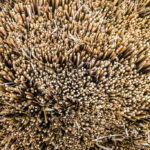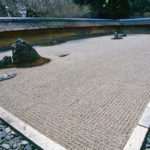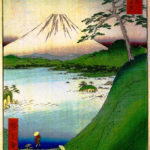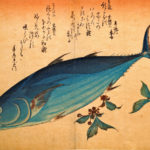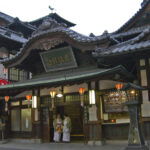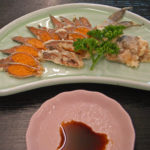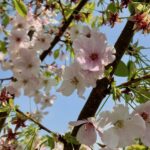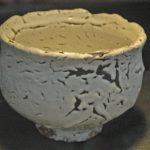For many Japanese, the era in its history a millennium ago was something of a Golden Age. From 794 to 1185, Japan was in its Heian period, and it was a time of tremendous cultural flowering, most conspicuously in the field of literature. Among the remarkable works to appear then was the brilliantly original Pillow Book, written by poet and courtier Sei Shonagon. In that volume, the author brought her sharp intelligence and sharply acidulous wit to bear in observing the world around her, most notably by making lists of items that caught her magpie-like attention. Her very entertaining listings include such items as “things that should be large,” “things that are near though distant” and “things that lose by being painted.” Two of the most memorable are “elegant things” and “splendid things.” And in those latter two lists of estimable items, only one flower has the merit to appear in both: it is the elegant, splendid wisteria.
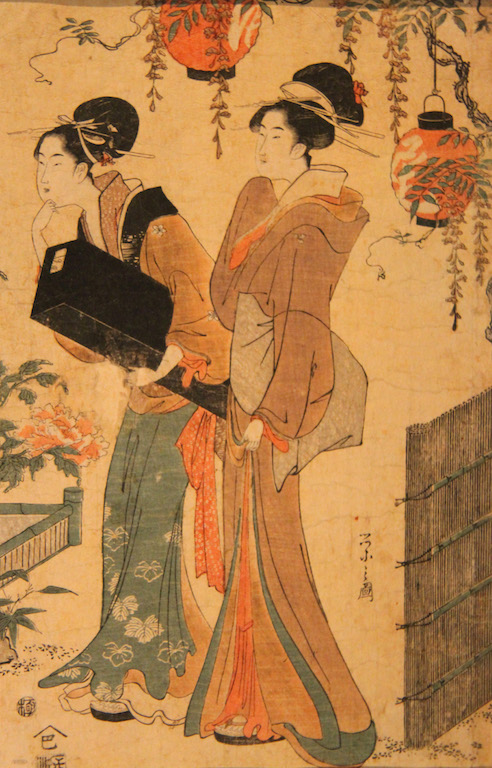
This ukiyo-e woodblock print by Chobunsai Eishi (1756–1829) is entitled “Beauties with Wisteria.”
For many Japanese, the era in its history a millennium ago was something of a Golden Age. From 794 to 1185, Japan was in its Heian period, and it was a time of tremendous cultural flowering, most conspicuously in the field of literature. Among the remarkable works to appear then was the brilliantly original Pillow Book, written by poet and courtier Sei Shonagon. In that volume, the author brought her sharp intelligence and sharply acidulous wit to bear in observing the world around her, most notably by making lists of items that caught her magpie-like attention. Her very entertaining listings include such items as “things that should be large,” “things that are near though distant” and “things that lose by being painted.” Two of the most memorable are “elegant things” and “splendid things.” And in those latter two lists of estimable items, only one flower has the merit to appear in both: it is the elegant, splendid wisteria.
The wisteria is a deciduous climbing shrub and botanically a member of the legume or pea family. It is native to Japan and grows wild in mountainous areas of the country, and it happily climbs up tall trees, typically on the edges of woodlands. In late April, sweetly fragrant clusters of wisteria flowers begin to appear, ranging from white to rich purple. But it is the latter color that is most commonly associated with wisteria and appears most frequently in Japanese art, that color being traditionally associated with the emperor and aristocracy.
In that era when Sei Shonagon was assiduously compiling her fascinating lists, wisteria was planted in the inner palace in Kyoto, then the capital of the country, for the visual delight of the emperor’s consorts and ladies-in-waiting. The great literary rival and contemporary of Sei Shonagon was the author of the monumental The Tale of Genji, Murasaki Shikibu (and not coincidentally murasaki in Japanese means “purple”). In that stunning work, which has fair claims for being both the world’s first novel and the finest piece of literature in Japanese, Murasaki conspicuously gives the name Fujitsubo (“Wisteria Pavilion”) to the most ideal of the titular Prince Genji’s many, many, many lovers.
Historically, in that Heian period, the most powerful force in the country was without doubt the Fujiwara clan. Superficially, the emperor may have been regarded as the one in control. But it was the Fujiwaras, who steadfastly saw to it that their daughters intermarried with the imperial family, that really pulled the strings. Their family name means “Wisteria Field,” and so the Fujiwaras took that flower as their symbol, and it appeared in their family crest. In later ages, others did likewise, and wisteria frequently figures among other family crests as well as in such decorative ways as kimono designs.
With its delicate scent and profusion of elegant blossoms hanging from gnarled vines, an air of romance seems to hang over the wisteria, and so it is hardly surprising that it has exerted such a strong impact on Japanese culture. In an age long after the Fujiwaras had lost their clutch on the reins of absolute power, the wisteria continued to beguile. Otsu-e was a genre of folk pictures that were sold at roadside stands near Otsu (present-day Shiga Prefecture). The images were popular with people traveling on the Tokaido, the main highway connecting Kyoto with Edo (today’s Tokyo). Among the folk paintings, one of the bestselling images was that of Fuji Musume (“Wisteria Maiden”). The young woman was depicted in rough brush strokes and a few strong colors wearing a long-sleeved kimono and with a flowering wisteria vine over her shoulder. Subsequently, Fuji Musume underwent a media crossover when she figured in kabuki, and Fuji Musume remains today one of the most popular and famous of kabuki dances.
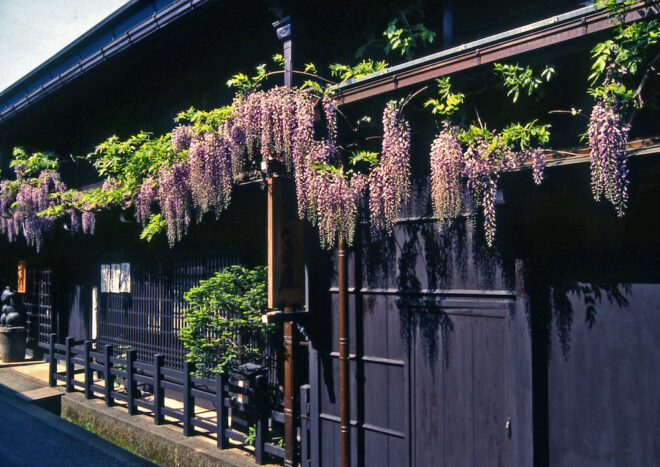
Wisteria makes a decorative addition to the facade of old townhouses in Takayama, Gifu Prefecture.
DAVID CAPEL
Wisteria as plant and flower may present rather an engaging sight, but it is not to be sniffed at—well, other than literally. Being a member of the pea family, it produces seeds in pods, which are huge things up to 20 centimeters long. And those seeds are poisonous—not poisonous as in strychnine poisonous, but enough to cause severe gastroenteritis when consumed by children or pets. Physically, wisteria can also be a rather tough customer. When wisteria is allowed to climb a trellis or other supporting structure, that support has got to be made of strong stuff: with thick trunks and stems, mature wisteria is immensely powerful and can crush frail structures and even strangle large trees.
If given the freedom, the stems of wisteria can grow to inordinate lengths, and that feature is often used for spectacular ornamental effect. Ashikaga Flower Park in Tochigi Prefecture is rather proud of its 350 wisterias, but most especially of its Great Wisteria. Around 150 years old, the Great Wisteria sprawls out over an area of more than 1,000 square meters and is so impressive it has been designated as a Natural Monument.
Japan is in fact home to two species of wisteria, and for those with an inclination for botanical precision, an idiosyncrasy of their climbing proclivity allows them to be readily distinguished. The native Japanese wisteria (noda-fuji) always twines upward around stationary objects in clockwise fashion. The Chinese wisteria (yama-fuji) winds in the opposite direction. And it is somehow rather charming that the story of wisteria in Japan should come with this little twist.
Wisteria makes a delightful appearance in the work of Basho, arguably the finest poet of the Edo period (1603–1867) and consummate master of the form that is now known as haiku. During the last decade of his life, Basho undertook extensive travels to famous places in Japan, often on foot and frequently also in less than good health. In the following poem, he describes how he was very weary, in a wretched state and longing for physical respite. But he then found himself instead confronted with a natural sight that lent delight for the soul:
Exhausted, I sought
an inn—instead found flowers
of wisteria.
David Capel is a journalist living in Tokyo.
NOTE: Updated April 2023

